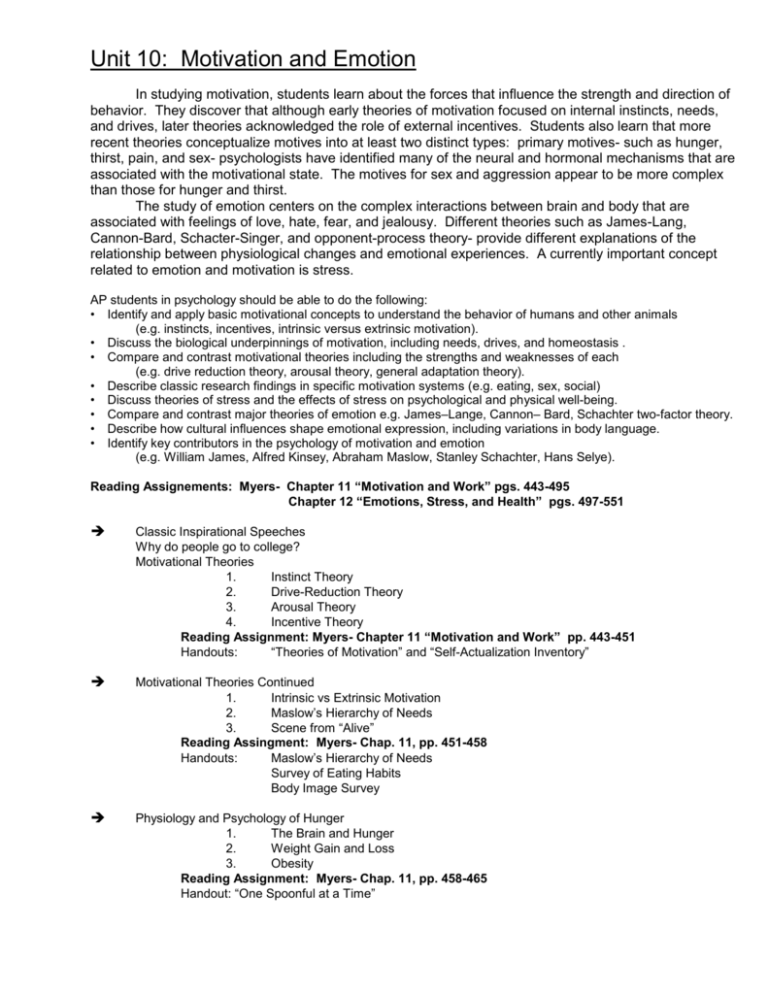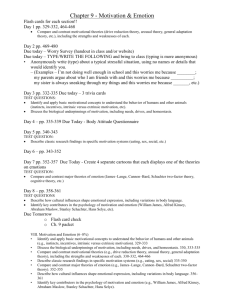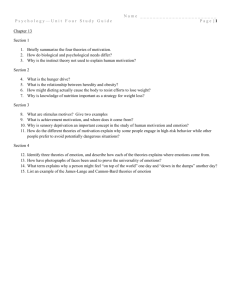MOTIVATION AND EMOTION
advertisement

Unit 10: Motivation and Emotion In studying motivation, students learn about the forces that influence the strength and direction of behavior. They discover that although early theories of motivation focused on internal instincts, needs, and drives, later theories acknowledged the role of external incentives. Students also learn that more recent theories conceptualize motives into at least two distinct types: primary motives- such as hunger, thirst, pain, and sex- psychologists have identified many of the neural and hormonal mechanisms that are associated with the motivational state. The motives for sex and aggression appear to be more complex than those for hunger and thirst. The study of emotion centers on the complex interactions between brain and body that are associated with feelings of love, hate, fear, and jealousy. Different theories such as James-Lang, Cannon-Bard, Schacter-Singer, and opponent-process theory- provide different explanations of the relationship between physiological changes and emotional experiences. A currently important concept related to emotion and motivation is stress. AP students in psychology should be able to do the following: • Identify and apply basic motivational concepts to understand the behavior of humans and other animals (e.g. instincts, incentives, intrinsic versus extrinsic motivation). • Discuss the biological underpinnings of motivation, including needs, drives, and homeostasis . • Compare and contrast motivational theories including the strengths and weaknesses of each (e.g. drive reduction theory, arousal theory, general adaptation theory). • Describe classic research findings in specific motivation systems (e.g. eating, sex, social) • Discuss theories of stress and the effects of stress on psychological and physical well-being. • Compare and contrast major theories of emotion e.g. James–Lange, Cannon– Bard, Schachter two-factor theory. • Describe how cultural influences shape emotional expression, including variations in body language. • Identify key contributors in the psychology of motivation and emotion (e.g. William James, Alfred Kinsey, Abraham Maslow, Stanley Schachter, Hans Selye). Reading Assignements: Myers- Chapter 11 “Motivation and Work” pgs. 443-495 Chapter 12 “Emotions, Stress, and Health” pgs. 497-551 Classic Inspirational Speeches Why do people go to college? Motivational Theories 1. Instinct Theory 2. Drive-Reduction Theory 3. Arousal Theory 4. Incentive Theory Reading Assignment: Myers- Chapter 11 “Motivation and Work” pp. 443-451 Handouts: “Theories of Motivation” and “Self-Actualization Inventory” Motivational Theories Continued 1. Intrinsic vs Extrinsic Motivation 2. Maslow’s Hierarchy of Needs 3. Scene from “Alive” Reading Assingment: Myers- Chap. 11, pp. 451-458 Handouts: Maslow’s Hierarchy of Needs Survey of Eating Habits Body Image Survey Physiology and Psychology of Hunger 1. The Brain and Hunger 2. Weight Gain and Loss 3. Obesity Reading Assignment: Myers- Chap. 11, pp. 458-465 Handout: “One Spoonful at a Time” Eating Disorders 1. Anorexia Nervosa 2. Bulimia Nervosa 3. Body Image Reading Assingment: Myers, Chap. 11, pp. 465-478 Handout: “Sexual Opinion Survey” Sexual Motivation 1. Sexual Response System 2. Sexual Orientation Reading Assignemt: Myers- Chap. 11, 478-493 Handout: “Improving Motivation in Sports – Self Efficacy” Who Committed the Crime? Theories of Emotion 1. James-Lang 2. Cannon-Bard 3. Schacter’s Two-Factor Reading Assignment: Myers- Chap. 12 “Emotions, Stress and Health” pp. 497-507 Handout: “Theories of Emotion” Physiology of Emotions 1. Arousal 2. Theories of Emotion Wkst. Reading Assignment: Myers- Chap. 12, pp. 507-514 Handout: PANAS Wkst. Expressing Emotions 1. Nonverbal Comm 2. Expression of Emotion Activity 3. Facial Expression: Ekman’s Research--Lie to Me. 4. Spot the Fake Smile Reading Assignment: Myers- Chap. 12, pp. 514-526 Handout: “Facial Expression: Not Global” Experiencing Emotion 1. Anger--“Fried Green Tomatoes” 2. Fear 3. Happiness Handout: “Emotions Questionnaire” Reading Assignment: Myers- Chap. 12, pp. 527-534 The Scope of Health Psychology Stress/ Personal Factors/ Cognitive Factors/ Environmental Factors/ Socio-cultural Factors Reading Assignment: Myers- Chap. 12, pp. 534-542 Conflict and Stress Selye’s General Adaptation Syndrome Coping With Illness--Symptoms/ Patient/ Treatment Reading Assignment: Myers, Chap. 12, pp. 542-551 Promoting Health: Smoking/ Eating Problems/ Exercise Preview Exam for “Motivation and Emotion” Unit Exam for “Motivation and Emotion”






